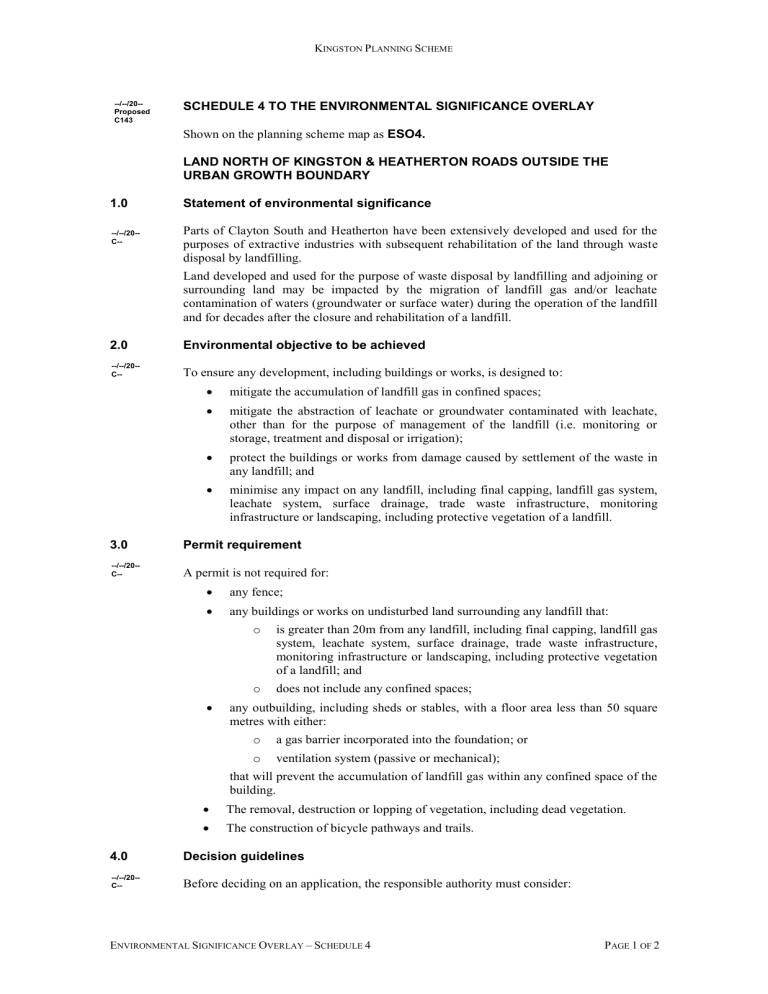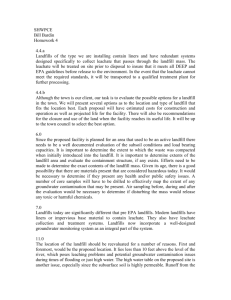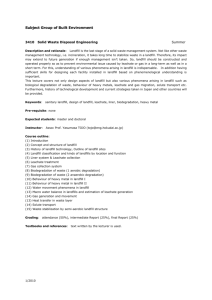Clause-4201s04-Schedule-4-to-the-Environmental

K INGSTON P LANNING S CHEME
--/--/20--
Proposed
C143
1.0
--/--/20--
C--
2.0
--/--/20--
C--
3.0
--/--/20--
C--
4.0
--/--/20--
C--
SCHEDULE 4 TO THE ENVIRONMENTAL SIGNIFICANCE OVERLAY
Shown on the planning scheme map as ESO4.
LAND NORTH OF KINGSTON & HEATHERTON ROADS OUTSIDE THE
URBAN GROWTH BOUNDARY
Statement of environmental significance
Parts of Clayton South and Heatherton have been extensively developed and used for the purposes of extractive industries with subsequent rehabilitation of the land through waste disposal by landfilling.
Land developed and used for the purpose of waste disposal by landfilling and adjoining or surrounding land may be impacted by the migration of landfill gas and/or leachate contamination of waters (groundwater or surface water) during the operation of the landfill and for decades after the closure and rehabilitation of a landfill.
Environmental objective to be achieved
To ensure any development, including buildings or works, is designed to:
mitigate the accumulation of landfill gas in confined spaces;
mitigate the abstraction of leachate or groundwater contaminated with leachate, other than for the purpose of management of the landfill (i.e. monitoring or storage, treatment and disposal or irrigation);
protect the buildings or works from damage caused by settlement of the waste in any landfill; and
minimise any impact on any landfill, including final capping, landfill gas system, leachate system, surface drainage, trade waste infrastructure, monitoring infrastructure or landscaping, including protective vegetation of a landfill.
Permit requirement
A permit is not required for:
any fence;
any buildings or works on undisturbed land surrounding any landfill that: o is greater than 20m from any landfill, including final capping, landfill gas system, leachate system, surface drainage, trade waste infrastructure, monitoring infrastructure or landscaping, including protective vegetation of a landfill; and o does not include any confined spaces;
any outbuilding, including sheds or stables, with a floor area less than 50 square metres with either: o a gas barrier incorporated into the foundation; or o ventilation system (passive or mechanical); that will prevent the accumulation of landfill gas within any confined space of the building.
The removal, destruction or lopping of vegetation, including dead vegetation.
The construction of bicycle pathways and trails.
Decision guidelines
Before deciding on an application, the responsible authority must consider:
E NVIRONMENTAL S IGNIFICANCE O VERLAY
–
S CHEDULE 4 P AGE 1 OF 2
K INGSTON P LANNING S CHEME
the proximity of any buildings or works to any landfill, including final capping, landfill gas system, leachate system, surface drainage, trade waste infrastructure, monitoring infrastructure or landscaping, including protective vegetation of a landfill;
the impact of any buildings or works on any landfill, including final capping, landfill gas system, leachate system, surface drainage, trade waste infrastructure, monitoring infrastructure or landscaping, including protective vegetation of a landfill;
where any buildings or works include a confined space, the design of the buildings or works to mitigate the potential accumulation of landfill gas;
where any buildings or works include a bore or well for the abstraction of groundwater, the design of the bore or well to mitigate the abstraction of leachate or groundwater contaminated by leachate within an identified Groundwater
Quality Restricted Use Zone under the Environment Protection Act 1970 (Vic) or otherwise identified polluted groundwater;
any relevant standards, including as appropriate: o Australian Standard 1668.2-2012 titled ‘The use of ventilation and air conditions in buildings – mechanical ventilation in buildings’ and
Amendment 1-2013; and o
Australian Standard 1668.4-2012 titled ‘The use of ventilation and air conditions in buildings – natural ventilation of buildings’ and
Supplement 1-2002.
E NVIRONMENTAL S IGNIFICANCE O VERLAY
–
S CHEDULE 4 P AGE 2 OF 2






